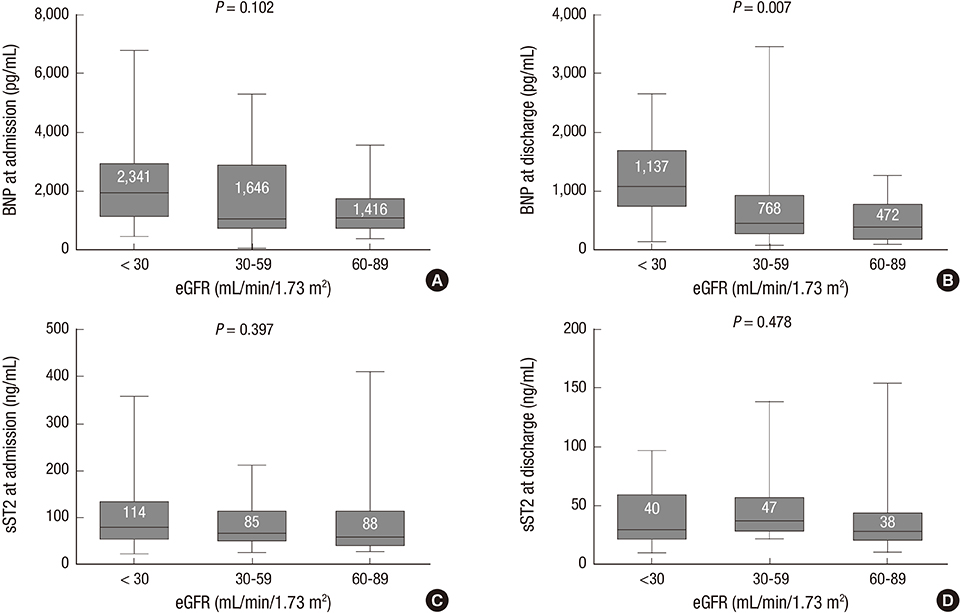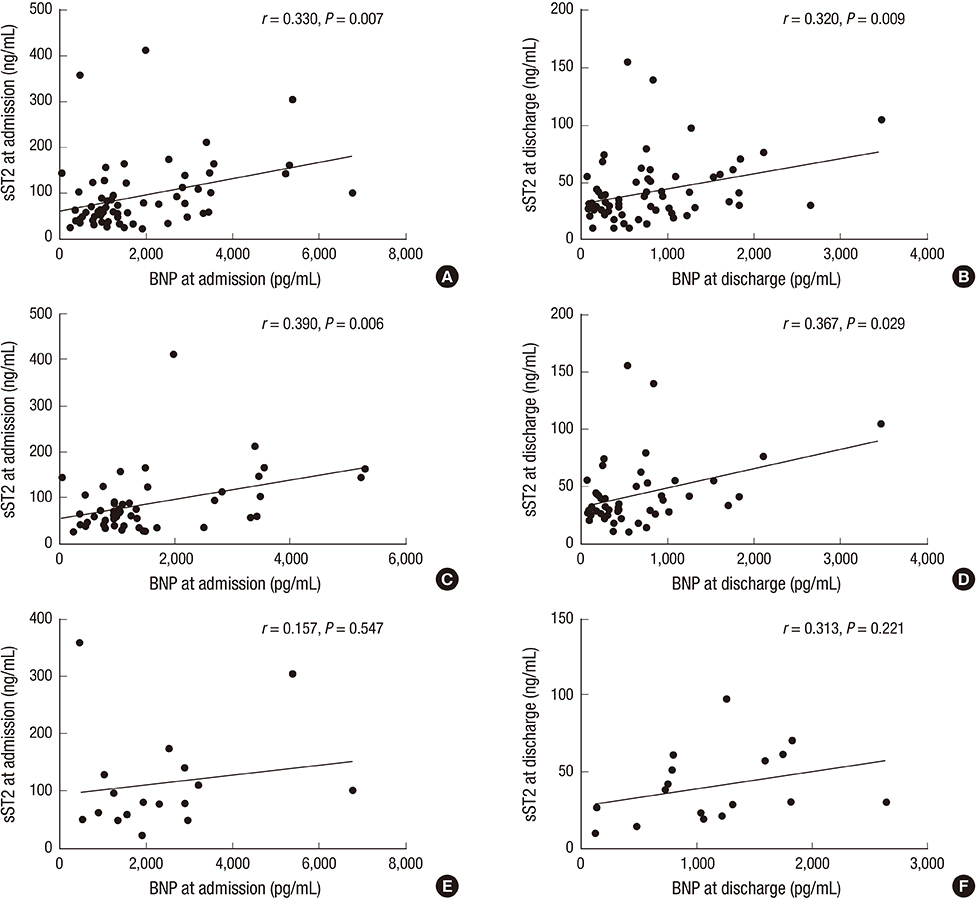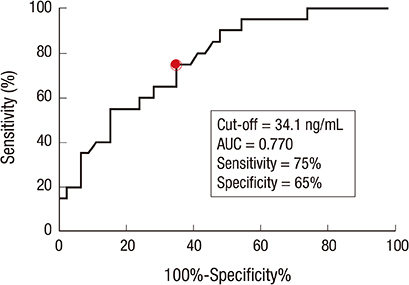J Korean Med Sci.
2015 May;30(5):569-575. 10.3346/jkms.2015.30.5.569.
Role of Soluble ST2 as a Prognostic Marker in Patients with Acute Heart Failure and Renal Insufficiency
- Affiliations
-
- 1Asan Medical Center Heart Institute, Department of Internal Medicine, University of Ulsan College of Medicine, Seoul, Korea. jjkim@amc.seoul.kr
- 2Department of Laboratory Medicine, Asan Medical Center and University of Ulsan College of Medicine, Seoul, Korea.
- 3Department of Applied Statistics, Gachon University, Seongnam, Korea.
- KMID: 2155469
- DOI: http://doi.org/10.3346/jkms.2015.30.5.569
Abstract
- This study sought to assess the relationship between serum concentrations of the soluble ST2 (sST2) and B-type natriuretic peptide (BNP) and investigate the role of sST2 as a prognosticator in patients hospitalized with acute heart failure (HF) and renal insufficiency. sST2 was measured at admission and discharge in 66 patients hospitalized with acute decompensated HF and renal insufficiency (estimated glomerular filtration rate [eGFR] < 90 mL/min/1.73 m2) using a high sensitivity immunoassay. BNP was sampled at the same time and compared to sST2. Demographical, biochemical, and echocardiographic data were also obtained during hospitalization.There were positive correlations between sST2 and BNP levels at admission (r = 0.330, P = 0.007) and at discharge (r = 0.320, P = 0.009) in overall patients. However, there was no correlation between them at each timepoint in patients with severe renal insufficiency (eGFR < 30 mL/min/1.73 m2, n = 17). sST2 level was not changed with the degree of renal function, even though BNP level was much higher in patients with severe renal insufficiency. During 3 month follow-up, 9 (13.6%) died and 16 (24.2%) were readmitted due to HF aggravation.On multivariate analysis, sST2 at discharge was independently associated with death or HF readmission during 3 months after discharge (hazard ratio, 1.038; 95% confidence interval, 1.011-1.066, P = 0.006). In conclusion, sST2 is not affected by renal function compared with BNP in acute HF patients. The measurement of predischarge sST2 can be helpful in predicting short-term outcomes in acute decompensated HF patients with renal insufficiency.
MeSH Terms
-
Acute Disease
Adolescent
Adult
Aged
Aged, 80 and over
Biomarkers/blood
Demography
Echocardiography
Female
Follow-Up Studies
Glomerular Filtration Rate
Heart Failure/complications/*diagnosis
Hospitalization
Humans
Immunoassay
Male
Middle Aged
Natriuretic Peptide, Brain/blood
Peptide Fragments/*blood
Prognosis
Proportional Hazards Models
Receptors, Cell Surface/*blood
Renal Insufficiency/complications/*diagnosis
Young Adult
Biomarkers
Natriuretic Peptide, Brain
Peptide Fragments
Receptors, Cell Surface
Figure
Cited by 1 articles
-
Role of biomarkers in the heart failure clinic
Bong-Joon Kim, Jae-Hyeong Park
Kosin Med J. 2022;37(1):4-17. doi: 10.7180/kmj.22.019.
Reference
-
1. Levin ER, Gardner DG, Samson WK. Natriuretic peptides. N Engl J Med. 1998; 339:321–328.2. Daniels LB, Maisel AS. Natriuretic peptides. J Am Coll Cardiol. 2007; 50:2357–2368.3. Anwaruddin S, Lloyd-Jones DM, Baggish A, Chen A, Krauser D, Tung R, Chae C, Januzzi JL Jr. Renal function, congestive heart failure, and amino-terminal pro-brain natriuretic peptide measurement: results from the ProBNP Investigation of Dyspnea in the Emergency Department (PRIDE) Study. J Am Coll Cardiol. 2006; 47:91–97.4. Richards M, Nicholls MG, Espiner EA, Lainchbury JG, Troughton RW, Elliott J, Frampton CM, Crozier IG, Yandle TG, Doughty R, et al. Christchurch Cardioendocrine Research Group. Australia-New Zealand Heart Failure Group. Comparison of B-type natriuretic peptides for assessment of cardiac function and prognosis in stable ischemic heart disease. J Am Coll Cardiol. 2006; 47:52–60.5. McCullough PA, Duc P, Omland T, McCord J, Nowak RM, Hollander JE, Herrmann HC, Steg PG, Westheim A, Knudsen CW, et al. Breathing Not Properly Multinational Study Investigators. B-type natriuretic peptide and renal function in the diagnosis of heart failure: an analysis from the Breathing Not Properly Multinational Study. Am J Kidney Dis. 2003; 41:571–579.6. Cataliotti A, Malatino LS, Jougasaki M, Zoccali C, Castellino P, Giacone G, Bellanuova I, Tripepi R, Seminara G, Parlongo S, et al. Circulating natriuretic peptide concentrations in patients with end-stage renal disease: role of brain natriuretic peptide as a biomarker for ventricular remodeling. Mayo Clin Proc. 2001; 76:1111–1119.7. Sanada S, Hakuno D, Higgins LJ, Schreiter ER, McKenzie AN, Lee RT. IL-33 and ST2 comprise a critical biomechanically induced and cardioprotective signaling system. J Clin Invest. 2007; 117:1538–1549.8. Weinberg EO, Shimpo M, De Keulenaer GW, MacGillivray C, Tominaga S, Solomon SD, Rouleau JL, Lee RT. Expression and regulation of ST2, an interleukin-1 receptor family member, in cardiomyocytes and myocardial infarction. Circulation. 2002; 106:2961–2966.9. Shimpo M, Morrow DA, Weinberg EO, Sabatine MS, Murphy SA, Antman EM, Lee RT. Serum levels of the interleukin-1 receptor family member ST2 predict mortality and clinical outcome in acute myocardial infarction. Circulation. 2004; 109:2186–2190.10. Weinberg EO, Shimpo M, Hurwitz S, Tominaga S, Rouleau JL, Lee RT. Identification of serum soluble ST2 receptor as a novel heart failure biomarker. Circulation. 2003; 107:721–726.11. Bayes-Genis A, Zamora E, de Antonio M, Galán A, Vila J, Urrutia A, Diez C, Coll R, Altimir S, Lupón J. Soluble ST2 serum concentration and renal function in heart failure. J Card Fail. 2013; 19:768–775.12. Yancy CW, Jessup M, Bozkurt B, Butler J, Casey DE Jr, Drazner MH, Fonarow GC, Geraci SA, Horwich T, Januzzi JL, et al. American College of Cardiology Foundation/American Heart Association Task Force on Practice Guidelines. 2013 ACCF/AHA guideline for the management of heart failure: a report of the American College of Cardiology Foundation/American Heart Association Task Force on practice guidelines. Circulation. 2013; 128:e240–e327.13. Khalifeh N, Haider D, Hörl WH. Natriuretic peptides in chronic kidney disease and during renal replacement therapy: an update. J Investig Med. 2009; 57:33–39.14. Tagore R, Ling LH, Yang H, Daw HY, Chan YH, Sethi SK. Natriuretic peptides in chronic kidney disease. Clin J Am Soc Nephrol. 2008; 3:1644–1651.15. Brunner M, Krenn C, Roth G, Moser B, Dworschak M, Jensen-Jarolim E, Spittler A, Sautner T, Bonaros N, Wolner E, et al. Increased levels of soluble ST2 protein and IgG1 production in patients with sepsis and trauma. Intensive Care Med. 2004; 30:1468–1473.16. Dieplinger B, Januzzi JL Jr, Steinmair M, Gabriel C, Poelz W, Haltmayer M, Mueller T. Analytical and clinical evaluation of a novel high-sensitivity assay for measurement of soluble ST2 in human plasma--the Presage ST2 assay. Clin Chim Acta. 2009; 409:33–40.17. Rehman SU, Mueller T, Januzzi JL Jr. Characteristics of the novel interleukin family biomarker ST2 in patients with acute heart failure. J Am Coll Cardiol. 2008; 52:1458–1465.18. Bao YS, Na SP, Zhang P, Jia XB, Liu RC, Yu CY, Mu SH, Xie RJ. Characterization of interleukin-33 and soluble ST2 in serum and their association with disease severity in patients with chronic kidney disease. J Clin Immunol. 2012; 32:587–594.19. Boisot S, Beede J, Isakson S, Chiu A, Clopton P, Januzzi J, Maisel AS, Fitzgerald RL. Serial sampling of ST2 predicts 90-day mortality following destabilized heart failure. J Card Fail. 2008; 14:732–738.20. Breidthardt T, Balmelli C, Twerenbold R, Mosimann T, Espinola J, Haaf P, Thalmann G, Moehring B, Mueller M, Meller B, et al. Heart failure therapy-induced early ST2 changes may offer long-term therapy guidance. J Card Fail. 2013; 19:821–828.
- Full Text Links
- Actions
-
Cited
- CITED
-
- Close
- Share
- Similar articles
-
- Elevated levels of soluble ST2 but not galectin-3 are associated with increased risk of mortality in hemodialysis patients
- Role of Soluble ST2 as a Marker for Rejection after Heart Transplant
- Establishing Reference Intervals for Soluble ST2 Assay in a Korean Population
- Prognostic and Therapeutic Implications of Renal Insufficiency in Heart Failure
- Successful Angioplasty using Gadopentetate Dimeglumine in a Patient with Chronic Renal Insufficiency




